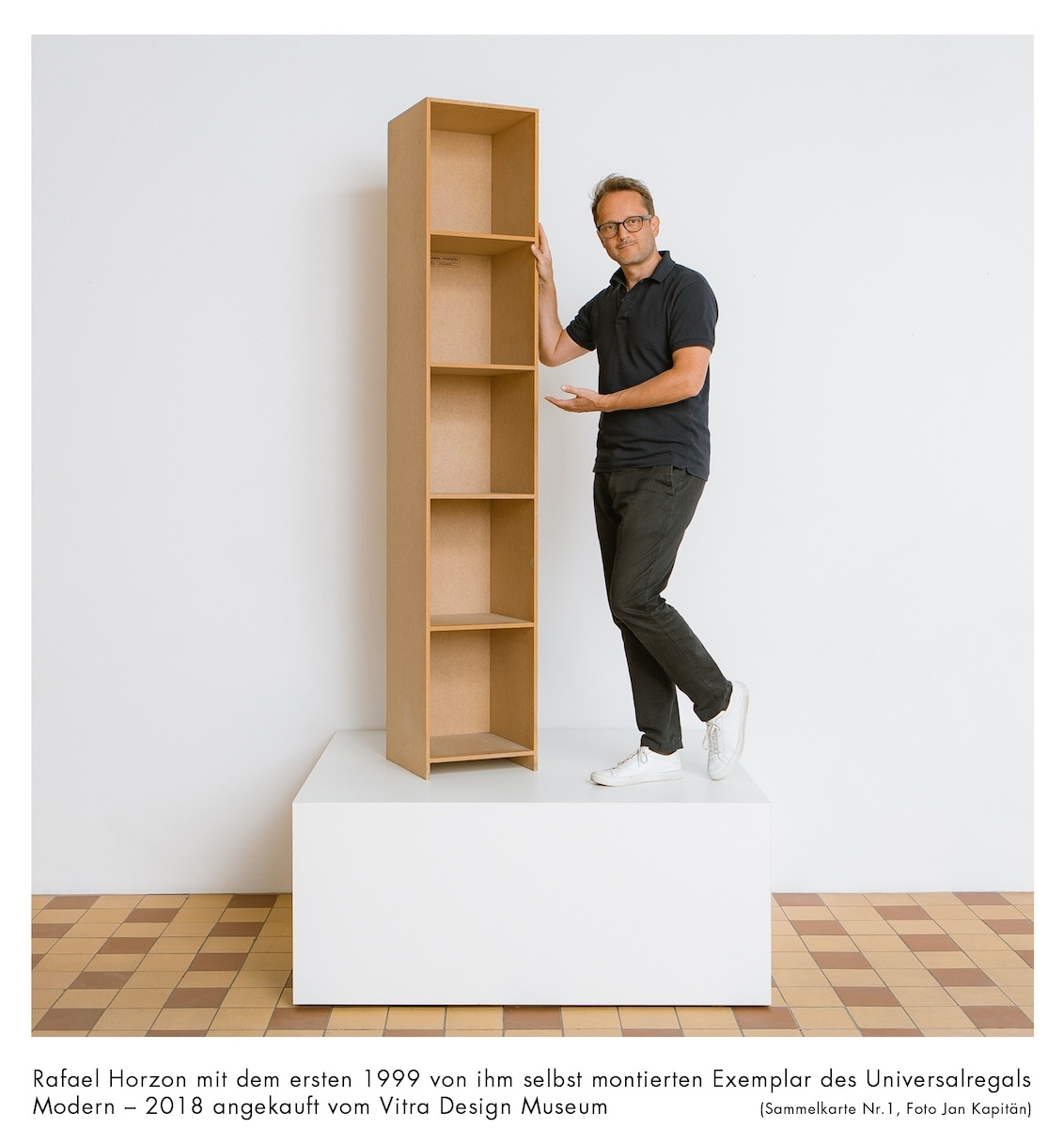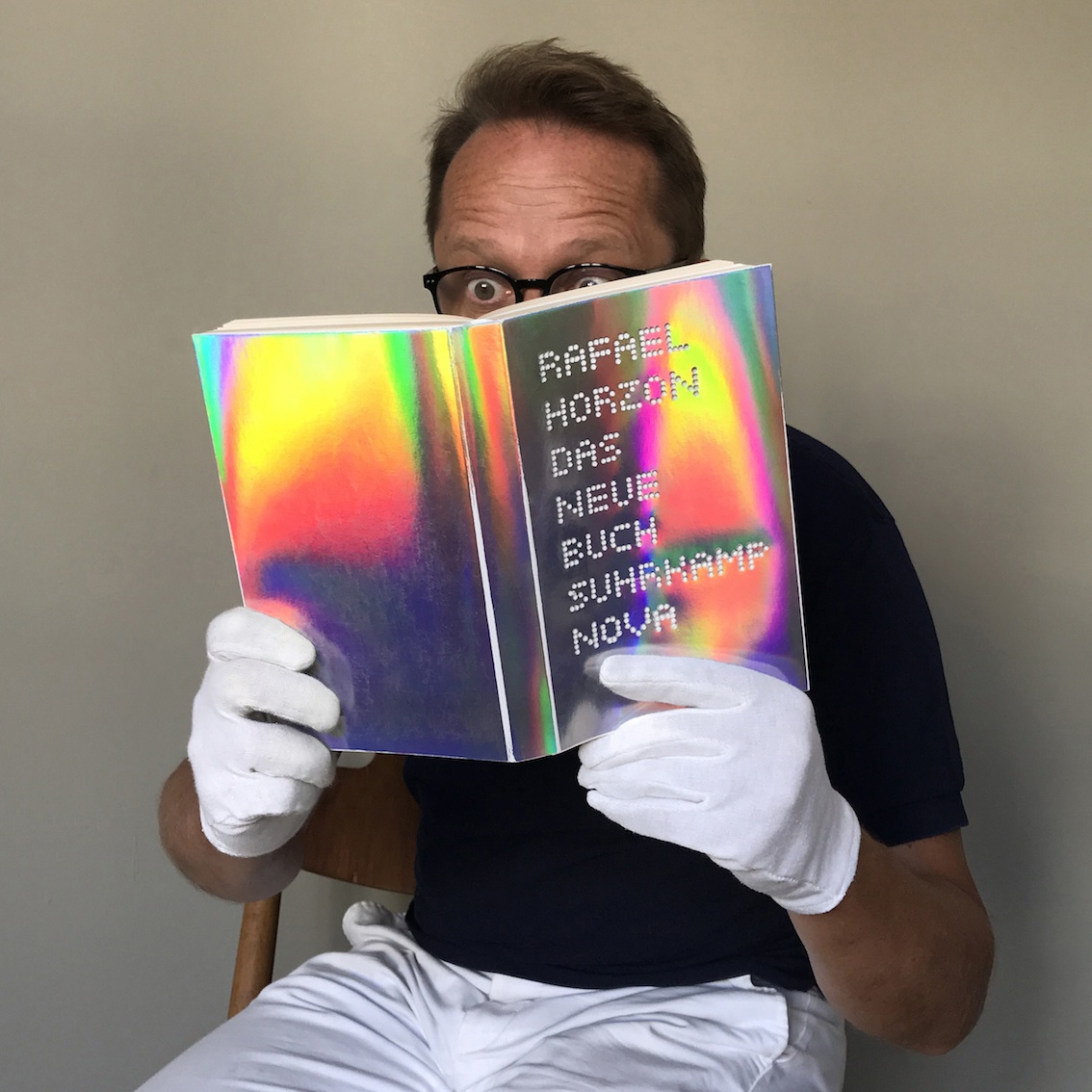KAIROS 19 – OBJECT 19
Als Kairos könnte man wohl den 8. Juli 1999 bezeichnen. Das war der Tag, an dem ich in der Torstrasse 68 in Berlin-Mitte meine erste MOEBEL HORZON Filiale eröffnete.
Günstig war der Ort (Torstrasse, damals noch sehr günstig), der Zeitpunkt (siehe vorherige Klammer), die Jahreszeit (Sommer) und die Uhrzeit (abends). Schnell entstand die grösste Eröffnungsgala, die Berlin je gesehen hatte. Noch wichtiger war aber, dass ich an diesem Tag meinen ersten selbstdesignten Gegenstand präsentierte, das Universalregal „Modern“. Und am allerwichtigsten war, dass an diesem Abend 20 dieser Regale bestellt wurden. Der Anfang meiner erfolgreichen Laufbahn als Designer und Unternehmer!
objekt: ein Bild von dir vor ein regal / an image of you in front of a shelf


ON Rafael Horzon
Rafael Horzon studierte Philosophie, Latein und Atomphysik in Paris, München und Berlin, bevor er 1996 als Fahrer in den Paket-Dienst der Deutschen Post wechselte.
Seit 1997 Gründung zahlreicher Unternehmen, darunter das Möbelhaus Moebel Horzon, Horzon’s Spülen Sparadies und Horzons Wanddekorationsobjekte.
2010 veröffentlichte Horzon seinen autobiografischen Bestseller „Das Weisse Buch“, der in zahlreiche Sprachen übersetzt wurde.
2018 wurde Horzons Gesamtwerk als Designer vom Vitra Design Museum angekauft, er gilt seitdem als „wohl wichtigster lebender Designer“ (Designmagazin DEAR).
Im September 2018 eröffnete Horzon in Berlin das Deutsche Zentrum für Dokumentarfotografie, 2019 den Fachmarkt „ Horzons Dämm & Deko“. Im Oktober 2020 erschien „Das Neue Buch“ von Rafael Horzon im Suhrkamp Verlag.

KAIROS 19 – A Talk with RAFAEL HORZON – 33 Participants
Zusammenfassung
Rafael Hormon // Kairos 19
Rafeal Horzon was introduced on our KAIROS page as „probably one of the most important living designers“. Very propably, some students felt that they had not seen him among the classic design icons until now. This is already the first mischievous twist of many that we have heard in the course of our conversation with Rafael about his person. Since he only created 4 designs in his career, and 2 were taken over by the vitra design museum, he can, by usual rules, call himself as probably one of the most important living designers.
His way of communicating and working was the first point of discussion in our talk. Axel describes his tireless source of humour as a trick to be able to constantly reinvent something using the leverage of humour to take existing things in the world, turn them upside down and make something new out of them.
Rafael cites his ‘Wanddekorationsobjekte’ (engl.: wall decoration objects) made of coloured plexiglass strips, as also used by Anselm Reile in a work of art. If you call these strip paintings wall decoration objects rather than works of art, they become something completely different. So perhaps it simply depends on how you talk about things.
A similar thing happened with his gallery Berlin Tokyo in 1996, where he tested the system of art and whether it would really be so easy to hang simple objects, such as a Japanese packet of crisps, on the wall and declare it to be art and then have it be perceived as such. He exposed the system of art by undermining it. Axel concludes that this twisting is a typical means of humour and leads to awareness. Axel therefore finds that his approach is not a joke, but political design. Existing values that we deal with are made to tilt and Horzon keeps this tilt in a fragile balance that is very interesting in Axel’s eyes.
With his first product, a shelving system, and his company Möbel Horzon, Rafael is pursuing an age-old principle in Axel’s eyes: urban local production, a system of industrially produced semi-finished products that are brought to the point of sale without middlemen and personal contact to the clients.Doing this, he feeds a certain culture, then invests in a new idea, and a never-ending well of a bread-and-butter principle emerges.
Rafale says it was all completely unplanned, that he still has no idea of the processes that product designers go through, and that he thinks a system like middlemen should be overturned anyway. As designers, we have to think more simply – He needed a shelf himself, bought MDF boards at Obi and screwed them together. He then placed this shelf as the only object in a completely empty shop on Torstraße and had ‚the biggest and most beautiful opening gala Berlin had seen up to then‘.
It was interesting to listen to the self-evidence, almost audacity, with which Horzon detaches himself from existing systems in his projects, simplifies them, often makes fun of them and thus also points out absurdities in the systems with clarity. Many things simply don’t make sense the way they are handled and he does it differently.
For example, with his company Redesign Deutschland, founded in 2001, he has redesigned language and time calculation – a grammar consisting of 10 rules and time calculation in a decimal system (1000 days, 100 hours, 100 minutes, etc.).
If Horzon has to describe a strategy for becoming a successful designer: You shouldn’t have a strategy. You should try to have as much fun as possible and just go for it, try things out and don’t wait for a brief or an assignment. Have ideas, hold on to them and then, and this is the most important point, implement them! For him it was always important to have a place to try things out and see if it works without getting into debt. ‚Very important!‘
On this point he had good news for us: many shops in Berlin are empty due to the Corona situation and are cheaper again. There, something can move and they show a possibility to do interesting things without investing a lot of money. In his eyes, a shop has a completely different effect than a website. Besides, you can’t lose much and you can only take away good conversations, great opening galas and interesting experiences.
This brought us to the topic of design fairs, which Horzon has never been to – he doesn’t see the point. Nevertheless, he has direct ideas about the future of the fairs. If he were us, he would get together with others and simply set up a fair in Berlin himself, create a platform. It couldn’t be that difficult, others have done it too. In his opinion, we have to think in a deglobalised way today. You could really tell how clearly and simply he approaches things and how naturally he would implement them.
The talk with Rafael Horzon brings mixed feelings. With his work, he naturally criticises part of design and art, but he also reminds us as designers not to think in an unnecessarily complicated way and actually to do things.
Horzon sums it up very simply: if you have written a novel and you leave it in the drawer, it doesn’t exist. You have to go out with it. Otherwise, what you have created doesn’t exist either.
With a final word to us, he comes back to the shops: every crisis is also a time of change!
Kim Kuhl
